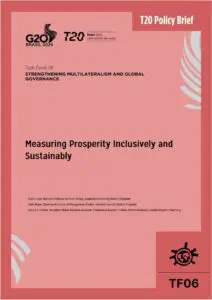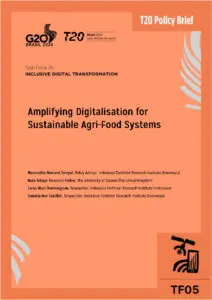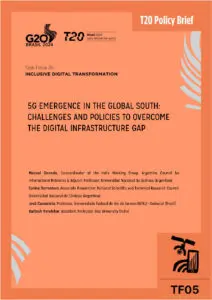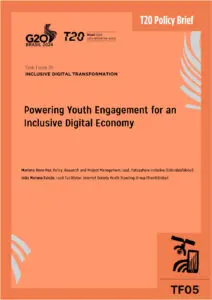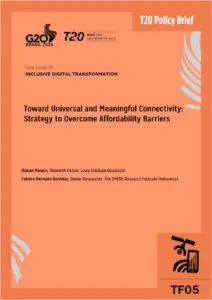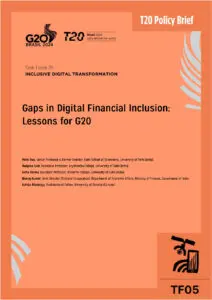This policy brief seeks to lay out a cost-effective transition pathway to a low-emissions transportation future. It highlights the effectiveness of technology-neutral frameworks that are focused on fuel economy improvements in the light- and heavy-duty vehicle sectors. It also provides measures for reducing the high costs associated with the deployment of zero-tailpipe emission technologies. Finally, it outlines an approach for transitioning to lower emissions mode within the freight transportation sector. In summary, the proposed pathway encompasses improving the efficiency of road transport in the near-to mid-term, and shifting to a more efficient mode in the long term.
Challenge
The transportation sector accounts for roughly 24% of global CO2 emissions (IEA 2019a). Knowing how best to enable the transition to a low-emissions transportation future that is affordable across different economies is an overarching challenge for the G20. We highlight three specific challenges in this transition:
- The road transport mode is the most utilized because of its convenience (Van Essen 2008). However, it is also the most emissions-intensive transportation mode. It accounts for 75% of global transport CO2 emissions (IEA 2019a). Within road transport, freight transport, being the least efficient, has the highest potential for greenhouse gas (GHG) emissions reduction (IEA 2017). However, it continues to remain the toughest sector to clean because of the associated technological and cost limitations (IEA 2017).
- One way to lower road transport emissions is through the deployment of zerotailpipe emission technologies. However, such a measure is expensive (Sheldon and Dua 2018). The cost of reducing tailpipe CO2 can be as high as $1000 per tonne— roughly an order of magnitude higher than the social cost of carbon.
- Finally, promoting emissions reduction through multiple overlapping regulations often overburdens stakeholders, who would have to meet several targets simultaneously (Siddiki et al. 2018). This then limits stakeholders’ ability to choose the most cost-effective pathway to meet the long-term goal of emissions reduction.
This brief identifies two key proposals focused on cost-effective policy designs for addressing these challenges.
Proposal
#1: Improve the cost-effectiveness of the light-duty vehicle (LDV) sector policies by adopting a targeted approach for demand-side fiscal policies and a unified, technology-neutral performance standards approach for supply-side regulatory policies
Rationale
G20 countries with supply- and demand-side policies have experienced greater reduction in GHG emissions from the LDV sector than those without such policy frameworks (IEA 2019b). Thus, widespread adoption of regulatory policies that set GHG emission targets, or fleet fuel economy targets, are crucial for incentivizing consumer uptake of energy-efficient LDVs.
As shown in Figure 1, over the 2040 horizon, policy-driven improvements in the fuel economy of internal combustion engine vehicles (ICEVs) could have a greater effect on oil consumption than vehicle electrification (IEA 2018; Albrahim et al. 2019; Kah 2019). However, vehicle electrification is still going to be crucial to ensure sustained rates of growth in overall fleet fuel economy improvement. It can also set the stage for future GHG emissions reductions by increasing the share of renewable energy in the electricity grid.

Promoting electric vehicle adoption through demand-side fiscal policies is expensive. For instance, the subsidy cost to reduce tailpipe CO2 can be as high as $1000 per tonne, as highlighted in Figure 2. This cost is roughly an order of magnitude higher than the social cost of carbon. The cost is high because the share of electric vehicle sales induced by the subsidy is low (Sheldon and Dua 2018), yet all purchases qualify for the subsidy. Moreover, the proportion of CO2 avoided through substitution by electric vehicles is low as well, as these vehicles tend to replace relatively fuel-efficient vehicles (see Figure 3) (Xing, Leard, and Li 2019).


On the other hand, a layered cake regulatory approach to promoting electrification that involves different supply-side policies (e.g., fuel economy performance standards and zero-emission vehicle mandates) places different requirements on manufacturers. Given that all stakeholders involved have finite resources, a more coordinated program might achieve the desired outcome at a lower overall societal cost.
Thus, while both supply- and demand-side policies are crucial for reducing GHG emissions in the LDV sector, major policy design adjustments are needed to improve the effect and cost-effectiveness of these policies.
Suggestions on means to implement
To improve the effect and cost-effectiveness of demand-side fiscal policies, policymakers in the G20 nations may opt for targeted subsidy designs based on either consumer income or vehicle price. Recent research suggests that such targeted subsidy designs could doubly improve policy cost-effectiveness (Sheldon and Dua 2020, 2019b). Real world pilot tests involving targeted subsidy designs for vehicle retirement and replacement have also proven to be more effective than non-targeted subsidy programs (Sheldon and Dua 2019a).
The G20 COVID-19 economic stimulus packages could involve targeted subsidy designs for promoting clean vehicle adoption (including hybrids) (CNN Business 2020; Financial Times 2020a, 2020b, 2020c; Avere 2020; Reuters 2020; Caixin 2020). Research suggests that previous stimulus packages, such as the 2009 Cash for Clunkers program in the U.S., led to minimal environmental gains or economic stimulus because of their low degree of targeting (Hoekstra, Puller, and West 2017; Knittel 2009). The environmental and economic stimulus effect of COVID-19 packages could be improved through targeted designs that promote clean vehicle sales (including hybrids), as highly targeted designs have been shown to induce additional sales (Sheldon and Dua 2019a).
The goals of different supply-side regulatory policies could be achieved through a unified, technology-neutral policy, where the ultimate objective is long-term GHG emissions reduction that is also highly cost-effective (Siddiki et al. 2018). This would require a combination of more stringent technology-neutral performance standards with credit-based mechanisms to incentivize the uptake of lower emission vehicles; an example includes the European Union’s CO2 emission standards for LDVs. The speed and extent of GHG emissions reduction would depend on the stringency of the implemented standards. A 70% improvement in ICEV stock fuel economy by 2040 could lead to an oil demand reduction of ~19.1 million barrels per day of oil equivalent by 2040 (=8.2 million metric tons of CO2 equivalent per day) (EPA 2019; Albrahim et al. 2019) (see Figure 1). Long-term commitments would also be needed to ensure appropriate investments are made for the development and deployment of clean vehicle technologies.
The G20 Transport Task Group (IPEEC 2014) could serve as a suitable platform for G20 countries to share experiences and collaborate on improving the cost-effectiveness of their respective supply- and demand-side policies through the above suggested recommendations
#2: Reduce regional freight transport energy consumption by the adoption of long-term integrated transport strategies, including fuel efficiency standards, modal shift, and railroad electrification.
Rationale
The modal share for transport varies widely by a country’s demography, geography, and economy. However, the share of transport energy demand in many developed and developing countries is skewed toward high energy-intensive road transport (IEA 2017).
Within road transport, real-world data offers evidence to highlight the difficulty of replacing oil demand with vehicle electrification. For nearly 30 years, Norway has funded aggressive policies that have raised the market share of electric vehicles to more than half of all new LDVs sold. Yet, the 2018 BP Statistical Yearbook indicates that 2018 marked Norway’s highest recorded oil consumption since 1965. Data from California—the most pro-electric vehicle jurisdiction in the U.S.—tell a similar story (Collins 2020).
The cases of California and Norway highlight a critical reality: electrifying LDVs accomplishes much less than improving the energy efficiency of the heavy-duty sector. There are far fewer trucks, planes, and ships in operation globally, yet each type of vehicle burns more fuel than cars do. A Boeing 737 jetliner that flies an average of seven hours per day for 350 days of the year uses as much fuel as approximately 325 heavy diesel trucks travelling 52,000 km per year apiece. In China—the secondlargest global oil consumer—these trucks consume 25 times the annual fuel of an average passenger car (Collins 2016). As such, helping these “big burners” use fuel more efficiently would facilitate core G20 goals and offer multiple actionable avenues for engagement.
Therefore, within freight transportation, G20 countries should acknowledge the importance of both modal share and road fleet fuel efficiency. Increasing the modal share of less energy-intensive modes, such as railways and waterways, should be the long-term goal of transport planning. In addition, electrification of rail transport can set the stage for future GHG emissions reductions by increasing the share of renewable energy in the electricity grid. An optimized modal share with maximum percentage of railways can reduce the overall transport energy intensity as well as carbon emissions (IEA 2019c). In addition to modal share, improving the fuel efficiency of road freight would also have a significant effect on the carbon emissions reduction (IEA 2017).
Suggestions on means to implement
The G20 should use existing platforms, such as the G20 Transport Task Group (IPEEC 2014), to develop country-wise roadmaps focused on integrated transport planning. In this case, greater emphasis should be placed on modal shift and railroad electrification. Beyond only environmental benefits, critical to the discussion is the need to highlight the scalable and sustainable economic benefits of a modal shift. The G20 Transport Task Group could also act as a data- and knowledge-sharing platform to promote standards and best practices adopted across G20 countries.
The Task Group could take stock of policy mechanisms and initiatives across G20 countries for improving the fuel efficiency of heavy-duty vehicle fleets. Among the various policy options, technology-neutral performance standards with credit-based mechanisms to incentivize the adoption of lower emission vehicles for niche freight applications represent a viable approach.
Summary
The current brief recommends a set of policy proposals to enable an affordable transition to a low-emissions transportation future. We recommend each G20 nation to
- Improve the cost-effectiveness of the policies of the LDV sector by adopting a targeted approach for demand-side fiscal policies and a unified, technologyneutral performance standards approach for supply-side regulatory policies. This measure includes:
- Incorporating targeted subsidy designs for promoting clean vehicle adoption (including hybrids) in the G20 COVID-19 economic stimulus packages based on either household income or vehicle price.
- Combining the different supply-side regulatory policies into a unified, technology-neutral performance standard with credit-based mechanisms in order to incentivize the uptake of vehicles with lower emissions.
- Using the G20 Transport Task Group as a platform to align and, thus, collaborate on improving the cost-effectiveness of their domestic policies through the above suggested recommendations.
- Reduce regional freight transport energy consumption by adopting long-term integrated transport strategies, including fuel efficiency standards, modal shift, and railroad electrification.
Disclaimer
This policy brief was developed and written by the authors and has undergone a peer review process. The views and opinions expressed in this policy brief are those of the authors and do not necessarily reflect the official policy or position of the authors’ organizations or the T20 Secretariat.
References
Albrahim, Mohammed, Ahmed Al Zahrani, Anvita Arora, Rubal Dua, Bassam Fattouh, and Adam Sieminski. 2019. “An Overview of Key Evolutions In the Light-Duty Vehicle Sector and their Impact on Oil Demand.” Energy Transitions 3, no. 1: 81–103. https://doi.org/10.1007/s41825-019-00017-7.
Avere. 2020. “Letter to the European Commission: E-Mobility at the Heart of the Upcoming EU Recovery Plan.” Accessed June 10, 2020. https://www.avere.org/letter-to-the-european-commission-e-mobility-at-the-heart-of-the-upcoming-eurecovery-plan.
Caixin. 2020. “Automakers Call for Stimulus as Industry Navigates Coronavirus Carnage.” Accessed June 12, 2020. https://www.caixinglobal.com/2020-05-11/automakers-callfor-stimulus-as-industry-navigates-coronavirus-carnage-101552773.html.
CNN Business. 2020. “Germany Hands Out Cash for Electric Cars as Part of Huge New Stimulus Splurge.” Accessed June 11, 2020. https://edition.cnn.com/2020/06/04/business/germany-stimulus-electric-cars/index.html.
Collins, Gabrial. 2016. “China’s Evolving Oil Demand – Slowing Overall Growth, Gasoline Replacing Diesel as Demand Driver, Refined Product Exports Rising Substantially.” James A. Baker III Institute for Public Policy of Rice University.
Collins, Gabriel. 2020. “Oil was a Strategic Prize in 1940. It Likely will be in 2040 as well.” Accessed June 08, 2020. https://www.forbes.com/sites/thebakersinstitute/2020/04/06/oil-was-a-strategic-prize-in-1940-it-likely-will-be-in-2040-as-well/#43be18d56967.
Davis, Steven J., Nathan S. Lewis, Matthew Shaner, Sonia Aggarwal, Doug Arent, Inês L. Azevedo, et al. 2018. “Net-Zero Emissions Energy Systems.” Science 360, no. 6396: eaas9793. https://doi.org/10.1126/science.aas9793.
EPA. 2019. “Greenhouse Gases Equivalencies Calculator – Calculations and
References.” Accessed June 15, 2020. https://www.epa.gov/energy/greenhousegases-equivalencies-calculator-calculations-and-references.
Financial Times. 2020a. “Carmakers should Emerge Greener from the Crisis.” Accessed June 14, 2020. https://www.ft.com/content/96ae2d26-9f4f-11ea-b65d-489c67b0d85d.
—. 2020b. “Emmanuel Macron injects €8bn to Fuel French Car Industry Revival.” Accessed June 10, 2020. https://www.ft.com/content/8e84e13b-d02f-4d90-839df99c3a0c1d95.
—. 2020c. “German Car Industry gets Cold Shoulder from Berlin.” Accessed June 14, 2020. https://www.ft.com/content/2935b9f5-b00f-4f65-afa8-3542dff1ce60.
Hoekstra, Mark, Steven L. Puller, and Jeremy West. 2017. “Cash for Corollas: When Stimulus Reduces Spending.” American Economic Journal: Applied Economics 9, no.3: 1–35. https://doi.org/10.1257/app.20150172.
IEA. 2019b. “Fuel Economy in Major Car Markets.” Accessed June 15, 2020. https://www.iea.org/reports/fuel-economy-in-major-car-markets.
—. 2019c. “The Future of Rail – Opportunities for energy and the environment.” Accessed June 15, 2020. https://www.iea.org/reports/the-future-of-rail.
—. 2017. “The Future of Trucks – Implications for Energy and the Environment.” Accessed June 15, 2020. https://www.iea.org/reports/the-future-of-trucks.
—. 2019a. “Tracking Transport 2019.” Accessed June 11, 2020. https://www.iea.org/reports/tracking-transport-2019.
—. 2018. “World Energy Outlook 2018 – Fuels.” Accessed June 10, 2020. https://www.iea.org/weo2018/fuels.
IPEEC. 2014. “Transport Task Group (TTG) – IPEEC.” Accessed June 14, 2020. https://ipeec.org/cms/20-transport-task-group-ttg-.html.
Kah, Marianne. 2019. “Electric Vehicle Penetration and Its Impact On Global Oil Demand: A Survey of 2019 Forecast Trends.” Center on Global Energy Policy at Columbia University SIPA. Accessed June 5, 2020. https://energypolicy.columbia.edu/research/report/electric-vehicle-penetration-and-its-impact-global-oil-demandsurvey-2019-forecast-trends#_ftn3.
Knittel, Christopher R. 2009. “The Implied Cost of Carbon Dioxide under the Cash for Clunkers Program.” Accessed June 8, 2020. https://dx.doi.org/10.2139/ssrn.1630647.
Reuters. 2020. “VW CEO Calls for Economic Stimulus to Revive Auto Industry.” Accessed June 15, 2020. https://www.reuters.com/article/us-health-coronavirusvolkswagen-stimulu/vw-ceo-calls-for-economic-stimulus-to-revive-auto-industrytv-idUSKCN2292WR.
Sheldon, Tamara L, and Rubal Dua. 2019a. “Assessing the effectiveness of
California’s “Replace Your Ride”.” Energy Policy 132: 318–323. https://doi.org/10.1016/j.enpol.2019.05.023.
Sheldon, Tamara L, and Rubal Dua. 2020. “Effectiveness of China’s Plug-In
Electric Vehicle Subsidy.” Energy Economics 88: 104773. https://doi.org/10.1016/j.eneco.2020.104773.
Sheldon, Tamara L, and Rubal Dua. 2018. “Gasoline savings from clean vehicle adoption.” Energy Policy 120: 418-424. https://doi.org/10.1016/j.enpol.2018.05.057.
Sheldon, Tamara L, and Rubal Dua. 2019b. “Measuring the cost-effectiveness of electric vehicle subsidies.” Energy Economics 84: 104545. https://doi.org/10.1016/j.eneco.2019.104545.
Siddiki, Saba, Sanya Carley, Nikolaos Zirogiannis, Denvil Duncan, and John Graham. 2018. “Does Dynamic Federalism Yield Compatible Policies? A Study of the Designs of Federal and State Vehicle Policies.” Policy Design and Practice 1, no. 3: 215–232. https://doi.org/10.1080/25741292.2018.1505186.
Van Essen, Huib. 2008. “The Environmental Impacts of increased international Road and Rail Freight Transport-Past Trends And Future Perspectives.” Global Forum on Transport and Environment in a Globalising World. Accessed June 11, 2020. https://www.oecd.org/greengrowth/greening-transport/41380980.pdf.
Xing, Jianwei, Benjamin Leard, and Shanjun Li. 2019. “What Does an Electric Vehicle Replace?” Resources for the Future Working Paper 19-05. Accessed June 15, 2020. https://media.rff.org/documents/WP_19-05_Leard.pdf.



